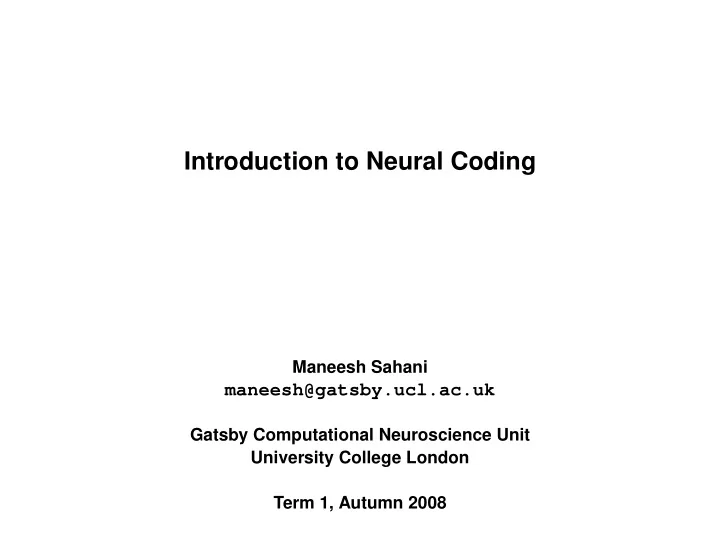

Introduction to Neural Coding Maneesh Sahani maneesh@gatsby.ucl.ac.uk Gatsby Computational Neuroscience Unit University College London Term 1, Autumn 2008
The CNS
Neocortex
Cortical layers
Neural signals (in vivo) Aggregate • aggregate fields – EEG, MEG, LFP • aggregate membrane voltage – die imaging • metabolism – fMRI, PET, intrinsic imaging Single neuron • extracellular – single neuron, spike sorting, cell attach • intracellular – sharp electrode, whole cell
Senses How many senses do you have? • taste (gustation) • smell (olfaction) • hearing (audition) • sight (vision) • touch (somatosensation) • pain (nociception) • body configuration (proprioception) • acceleration and balance (vestibular sense)
Neocortical senses
Sensory areas
Common features of neocortical senses • common pathways: receptors – subctx nuclei – thalamus – primary ctx – higher ctx • thalamic loops between cortical areas • feedback • parallel hierarchy • alternate pathways – tectal, para-lemniscal
Common processing • receptor discretisation – sampling • receptive fields • contrast sensitivity – Weber’s law • adaptation – neural vs. psychological – adaptation to higher features – mismatch negativity – statistical adaptation
Quantifying responses • receptive fieds • motor fields • stimulus-response functions • sensory computation and encoded variables • tuning curves
Optimality of coding • “impedence” matching between different components • matching to natural statistics • matching to behaviourally relevant features • redundancy reduction
The eye and retina
Centre-surround receptive fields
Colour at the retina
Centre-surround models Centre-surround receptive fields are commonly described by one of two equations, giving the scaled response to a point of light shone at the retinal location ( x, y ) . A difference-of-Gaussians (DoG) model: − ( x − c x ) 2 + ( y − c y ) 2 − ( x − c x ) 2 + ( y − c y ) 2 1 � � 1 � � D DoG ( x, y ) = exp exp − 2 πσ 2 2 σ 2 2 πσ 2 2 σ 2 c c s s 0.06 0.05 0.06 0.04 0.04 0.03 0.02 0.02 0 0.01 −0.02 10 5 10 0 5 0 0 −5 −5 −0.01 −10 −10 −5 0 5 10 −10
Centre-surround models . . . or a Laplacian-of-Gaussian (LoG) model: − ( x − c x ) 2 + ( y − c y ) 2 � � �� 1 D LoG ( x, y ) = −∇ 2 2 πσ 2 exp 2 σ 2 0.06 0.05 0.06 0.04 0.04 0.03 0.02 0.02 0 0.01 −0.02 10 5 10 0 5 0 0 −5 −5 −0.01 −10 −10 −10 −5 0 5 10
Linear receptive fields The linear-like response apparent in the prototypical experiments can be generalised to give a predicted firing rate in response to an arbitrary stimulus s ( x, y ) : � r ( s ( x, y )) = dx dy D ( x, y ) s ( x, y ) The receptive field centres ( c x , c y ) are distributed over visual space. If we let D () represent the RF function centred at 0, instead of at ( c x , c y ) , we can write: � r ( c x , c y ; s ( x, y )) = dx dy D ( c x − x, c y − y ) s ( x, y ) which looks like a convolution.
Frequency effects Thus a repeated linear receptive field acts like a spatial filter. We can consider its frequency response. Both DoG and LoG models are bandpass. Taking 1D versions: 2 1 1.8 0.8 1.6 centre Gaussian 0.6 second derivative ( ω 2 ) 1.4 0.4 difference 1.2 0.2 response response 1 0 0.8 −0.2 Gaussian 0.6 −0.4 surround Gaussian 0.4 −0.6 product −0.8 0.2 −1 0 0 fmax 0 fmax frequency frequency
Edge detection Bandpass filters emphasise edges: orginal image DoG responses thresholded
Thalamic relay
Visual cortex
Orientation selectivity
Linear receptive fields – simple cells Linear response encoding: � ∞ � r ( t 0 , s ( x, y, t )) = dτ dx dy s ( x, y, t 0 − τ ) D ( x, y, τ ) 0 For separable receptive fields: D ( x, y, τ ) = D s ( x, y ) D t ( τ ) For simple cells: − ( x − c x ) 2 − ( y − c y ) 2 � � D s = exp cos ( kx − φ ) 2 σ 2 2 σ 2 x y
Linear response functions – simple cells
Simple cell orientation selectivity
Drifting gratings s ( x, y, t ) = G + Acos ( kx − φ ) cos ( ωt )
Separable and inseparable response functions Separable: motion sensitive; Inseparable: motion sensitive; not direction sensitive and direction sensitive
Complex cells Complex cells are sensitive to orientation, but, supposedly, not phase. One model might be (neglecting time) � 2 − ( x − c x ) 2 − ( y − c y ) 2 �� � � r ( s ( x, y )) = dx dy s ( x, y ) exp cos ( kx ) 2 σ 2 2 σ 2 x y � 2 − ( x − c x ) 2 − ( y − c y ) 2 �� � � + dx dy s ( x, y ) exp cos ( kx − π/ 2) 2 σ 2 2 σ 2 x y But many cells do have some residual phase sensitivity. Quantified by ( f 1 /f 0 ratio). Stimulus-response functions (and constructive models) for complex cells are still a mat- ter of debate.
Other V1 responses • end-stopping • blobs and colour • surround effects • . . .
Higher Visual Areas
Recommend
More recommend